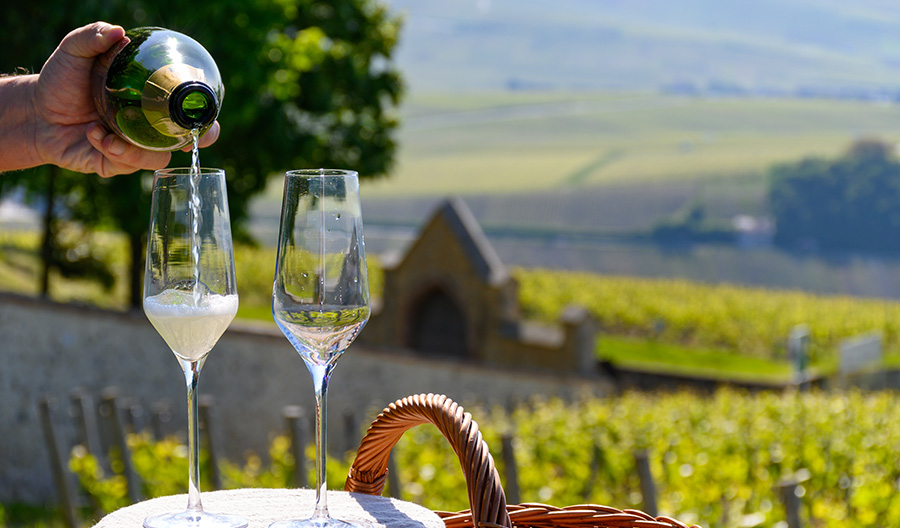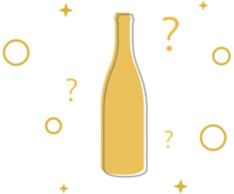Blanc de blancs is a sparkling wine term that is most closely associated with Champagne. Directly translating to “white of whites,” it means that the wine in bottles that bear the phrase is made exclusively from white grapes.
Seems simple, right? Not so fast.
Like many phrases that appear on wine labels, there’s a lot more nuance to the designation than meets the eye. First off, there can be a subtle difference between “blanc de blancs” (sparkling wines made with more than one varietal of white grape) and “blanc de blanc” (which is made from a single varietal of white grape). In Champagne, blanc de blanc is more common. These wines are made in the traditional method and are typically composed of Chardonnay grapes, which is how most well-informed consumers expect them to be made. But that’s not always the case. Moreover, the term now appears on bottles around the globe that may—or may not—differ vastly from blanc de blanc that hail from Champagne.
Depending on where they’re made and by whom, these wines can technically be produced via different techniques from different grapes. Here are all the details.
Not All Chardonnays Are Blanc de Blancs, but Most Blanc de Blancs Are Chardonnays
“When we say ‘blanc de blancs,’ we will always associate it with Chardonnay, but technically there are four other grapes that are allowed,” says the sommelier at an L.A. restaurant which boasts an extensive all-French wine list. They are Arbane, Petit Meslier, Pinot Blanc and Pinot Gris—which, not coincidentally, are also the only grapes that can be grown in Champagne outside of the region’s three primary grapes: red Pinot Noir and Pinot Meunier and white Chardonnay.
That said, if your Champagne is a blanc de blancs, it’s probably composed primarily of Chardonnay. And, if your blanc de blanc comes from Champagne’s top-producing blanc de blanc region—Côtes de Blancs—that’s even more likely. (Again, paying attention to whether or not there’s a “s” attached to the second blanc is a good clue.) These wines tend to be crisp and elegant with measured minerality. According to the Union des Maisons de Champagne, nearly 98% of all grapevines in the appellation are Chardonnay.
So, what is the difference between wines labeled “Chardonnay” and those marked “blanc de blanc”? Bubbles. Blanc de blanc and blanc de blancs, as previously mentioned, are sparkling wines, while bottles referred to as Chardonnay are still wines made from the Chardonnay grape.

Blanc de Blancs Around the World
Any place that grows quality Chardonnay is likely to produce some blanc de blanc and blanc de blancs—though not all are made in the méthode Champenoise.
Other regions are using white-skinned grapes to make sparkling wine, such as Spain’s Cava, which is made in the traditional method from the Macabeo, Xarel·lo, and Parellada grapes. These wines sometimes bear “blanc de blancs” on their labels.
There’s also Italy’s prosecco, which is made with the Glera grape. Blanc de blanc is similar to prosecco in that both are sparkling wines made exclusively from white grapes. In that sense, it’s technically correct to call it a blanc de blanc—although one usually does not find such terminology on the label. Further differentiating prosecco from most blanc de blanc, it’s produced in the charmat, or tank method, wherein the wine goes through secondary fermentation in stainless-steel tanks and is then bottled. (In the traditional method, juice undergoes a secondary fermentation in the bottle.) Wines produced in the tank method tend to have larger bubbles than those that are produced in the traditional method.
Wine labeled blanc de blanc and blanc de blancs—no matter where they come from—are generally made with the traditional method. However, there seem to be no hard and fast labeling rules on the style outside of France, which requires only that these wines are made of solely white grapes.
Is Blanc de Blanc More Expensive Than Other Sparkling Wine?
Because blanc de blanc is made with a single varietal, it can be more expensive than many other sparkling wines. This however, is a generalization with many exceptions—for example, most of the great collectible Champagnes contain red grapes and therefore do not qualify as blanc de blanc.
“It doesn’t have to be exponentially more expensive, but I think it typically is because when you have a single-variety wine anywhere—and certainly in Champagne—you can’t blend out issues with it,” says Christy Canterbury, Master of Wine. This means that if there’s an odd vintage—one with a shortened ripening season, for example, or one with great red grape yields but terrible Chardonnay yields—winemakers can be put on the spot.
“It can be really nice to have something to blend… to give it a little more softness, a little more structure or a little more whatever you need. When you don’t have that, it’s harder to make a more complete wine,” says Canterbury. Chardonnay can struggle when subjected to difficult weather conditions, he continues. “Having some Meunier or Pinot Noir or some other grape varieties to soften out the generally more rigid structural facets in Chardonnay can be very helpful in [non-blanc de blanc] Champagne.”
Another challenging factor is the availability of grapes. In total, nearly 69% of the grapes under vine in Champagne are red Pinot Meunier and Pinot Noir, while just under 31% of Champagne is planted with Chardonnay grapes.
When to Drink Blanc de Blancs, and Which One to Choose
Given their brightness, freshness and typically higher acidity compared to other sparklers (thanks to the Chardonnay), blanc de blanc and blanc de blancs from Champagne pair well with seafood, caviar and oysters. Canterbury likes to pair these wines, which can be described as having sharp edges, with creamier foods, say a French mushroom soup. She especially likes to pair it with a post-meal cheese course.
Of course, the right pairings will depend on the specific flavor qualities of an individual wine. California versions, for example, tend to be softer and creamier than their Champagne counterparts—a factor that should be taken into account when designing a pairing.
When helping someone choose the right wine, think about how it is going to be consumed and ask about price point and vintage. Help the customer understand that the older the vintage, the more fuller bodied the blanc de blancs will be. Because they tend to be even fresher, non-vintage blanc de blancs are great for celebrations.

